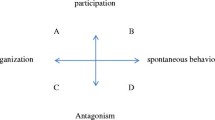The play in question here is not to be understood as a free activity productive of literary objects, but as long as journey punctuated with compelling choices that leads, through a series of exclusions and of options, manifesting personal phobias and euphorias, to the constitution of an original and unique work. [19: 86].
Abstract
The paper will discuss the role of the visual in French urban space. It will reveal the close connections between visual and semiotics where the visual dimension is central rather than marginal. We will evaluate altogether the psychological, legal and social impacts of the new shapes of our own environment. Rethinking our public space shapes our identities, unveils the ‘hidden’ powerful discourse behind these new urban models.










Similar content being viewed by others
References
Barthes, Roland. 1977. Elements of semiology (trans: Lavers, A. and Smith, C.). 1964; rptd. New York: Hill and Wang.
Bauman, Zygmunt. 2007. Le présent liquide. Peurs sociales et obsession sécuritaire. Paris: Seuil.
Bhatia, Vijay K., Engberg, Jan, Gotti, Maurizio and Heller Dorothee. 2005. (eds) Vagueness in Normative Texts, Bern: Peter Lang.
Pierre, Bourdieu. 1999. Language and symbolic power. Harvard: Havard University Press.
Branford, Victor, and Geddes Patrick. 1917/2009. The coming polity: A study of reconstruction. Cornell: Cornell University Library’s print collection.
Cramer, Renee Ann, and Marusek, Sarah. 2010. Signs of mothering in the built environment. Western Political Science Association 2010 Annual Meeting Paper (unpublished).
Davis, Mike. 1990. City of Quartz. Excavating the future of Los Angeles. London: Verso.
Dikeç, Mustafa. 2006. Two decades of French urban policy: from social development of neighbourhoods to the republican penal state. Antipode 38(1): 59–81.
Eco, Umberto. 1976. A Theory of semiotics. Bloomington: Indiana University Press.
Ellin, Nan. 1996. Postmodern Urbanism. Cambridge: Blackwell.
Fairclough, Norman. 1992. Discourse and social change. Cambridge: Polity Press.
Flusty, Steven. 1994. Building Paranoia: The proliferation of interdictory space and the erosion of spatial justice. West Hollywood: Los Angeles Forum for Architecture and Urban Design.
Foucault, Michel. 1975. Surveiller et punir. Naissance de la prison. Paris: Gallimard.
Foucault, Michel. 1984. Space, knowledge, and power. ed Paul Rabinow. The Foucault Reader, 239–256. New York: Pantheon.
Foucault, Michel. 1986. Of other spaces. Diacritics Spring: 22–27.
Foucault, Michel. 1991. Governmentality. In The Foucault effect: Studies in governmentality, ed. C. Gordon, G. Burchell, and P. Miller, 87–104. Chicago: University of Chicago Press.
Foucault, Michel. 1997. ‘Il faut défendre la société’ Cours au Collège de France 1975–1976. Paris: Seuil.
Gény, François. 1922. Sciences et Techniques en Droit Privé Positif. Paris: Recueil Sirey.
Julien, Greimas Algirdas, and Rastier François. 1968. The interaction of semiotic constraints. Yale French Studies 41: 86–105.
Hart, Herbert Lionel Adolphus. 1976. Le concept de droit, trad. Michel Van de Kerchove. Bruxelles: Facultés Universitaires Saint-Louis.
Huxley, Margo. 2007. Chapter 20—Geographies of Governmentality. eds. Jeremy W. Crampton and Stuart Elden, Space, knowledge and power—Foucault and Geography. Aldershot: Ashgate: 185–205.
Kevelson, Roberta. 1988. The law as a system of signs. New York & London: Plenum Press.
Kress, Gunther and van Leeuwen Theo. 1996/2006. Reading images: The grammar of visual design. London/NY: Routledge.
van Leeuwen, Theo. 2005. Introducing social semiotics. London/NY: Routledge.
van Leeuwen, Theo, and Carey Jewitt. 2001. Handbook of visual analysis. London: Sage.
Low, Setha, and Neil Smith (eds.). 2006. The politics of public space. New York: Taylor & Francis.
Low, Setha. 2003. Behind the gates: Life, security, and the pursuit of happiness in fortress America. New York: Routledge.
Marusek, Sarah. 2009. Legality beyond the scope of policy. In Images in law, ed. Anne Wagner, and Vijay K. Bhatia, 137–148. Aldershot: Ashgate.
Marusek, Sarah. 2007. Between disability and terror: Handicapped parking space and homeland security at Fenway park. International Journal for the Semiotics of Law 20(3): 251–261.
Marusek, Sarah. 2005. Wheelchair as semiotic: Space governance of the American handicapped parking space. Law, Text and Culture 9: 177–188.
Maslow, Abraham. 1943. A theory of human motivation. Psychological Review 50: 370–396.
Maslow, Abraham. 1937. The comparative approach to social behavior. Journal of Social Forces 15: 487–490.
McCormick, Neil. 1978. Legal reasoning and legal theory. Oxford: Oxford University Press.
Mitchell, Don. 2003. The right to the city. New York: Guilford.
Mitchell, William J. Thomas. 2005. What do pictures want?. Chicago: University of Chicago Press.
Molotch, Harvey. 1999. Growth machine links: Up, down and across. In The urban growth machine: Critical perspective two decades later, ed. Andrew E.G. Jonas, and Wilson David. Albany: State University of New York Press.
Peirce, Charles Sanders. 1931–1958. Collected papers. Cambridge, Mass: Harvard University Press.
Rousseau, Jean-Jacques. 1762/1993. Le contrat social. Paris: Editions Flammarion.
Saussure, Ferdinand de. 1913/1995. Cours de linguistique générale. Paris: Edition Payot.
Stone, Clarence. 1993. Urban regimes and the capacity to govern: A political economy approach. Journal of Urban Affairs 15(1): 1–28.
Summerfield, Tracey, and Alec McHoul. 2009. On sight/on site: visuality in native title claims: can we even speak? In Images in law, ed. Anne Wagner, and Vijay K. Bhatia, 149–166. Aldershot: Ashgate.
Wacquant, Loic. 2004. Punir les pauvres. Le nouveau gouvernement de l’insecurite sociale. Marseille: Agone.
Wagner, Anne, and William Pencak (eds.). 2006. Images in law. Aldershot: Ashgate.
Wagner, Anne. 2004. Les marques de lisibilité comme éléments de planification du discourse juridique anglais. Applied Semiotics (AS)/Sémiotique Appliquée (SA) (Learned Journal of Literary Research on the World Wide Web/Revue internationale de recherche littéraire sur Internet), Issue No. 14: 52–67.
Wagner, Anne. 2004. Le diagnostic de la pluralité en droit médical–‘The Human Fertilisation and Embryology Act 1990’ et ses implications. Semiotica. 151–1(4): 183–200.
Wagner, Anne. 2006. The rules of the road: A Universal visual semiotics. International Journal for the Semiotics of Law 19(3): 311–324.
Wilmotte, Jean-Michel. 1999. Architecture Interieure des Villes. Paris: Le Moniteur Editions.
Author information
Authors and Affiliations
Corresponding author
Rights and permissions
About this article
Cite this article
Wagner, A. French Urban Space Management: A Visual Semiotic Approach Behind Power and Control. Int J Semiot Law 24, 227–241 (2011). https://doi.org/10.1007/s11196-010-9206-5
Published:
Issue Date:
DOI: https://doi.org/10.1007/s11196-010-9206-5




